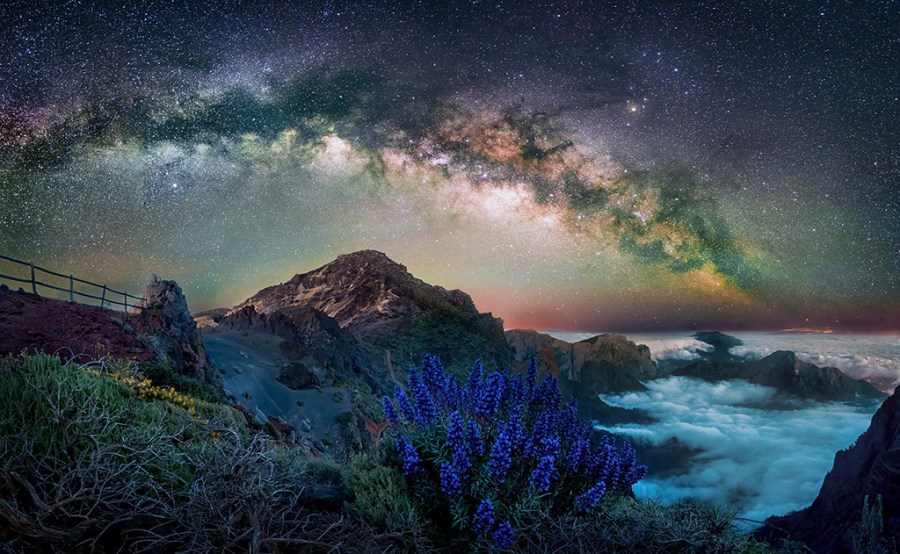Claire Gillo speaks to award-winning IGPOTY photographer Tony North about his stunning Blue Tajinaste image, an astro landscape composite.
To access the location where photographer Tony North took his award-winning image titled Tajinaste Azul, you have to keep going up – about 2300m up! The image was taken in La Palma (the Canary Islands) on the top of the northern edge of the Caldera in the Taburiente National Park, and it required a bit of effort to get there as Tony explains. ‘You drive all the way up the mountain, including twenty minutes of hairpin and nail-biting bends. You’re almost constantly in second and first gear, and then at the top of the road it takes you close to the rim of the Caldera and there are paths to follow with amazing views.’
It wasn’t by chance that Tony stumbled across this stunning location, and every aspect of the shoot was planned and scouted to a tee! ‘I initially wanted to include the most famous resident flora, the enormous Giant Viper’s Bugloss in the foreground,’ he tells me. However, he was unable to find a spot where he could frame these flowers in the foreground with the Milky Way view above. Eventually Tony found another rare local flower called the Echium Gentianoides but known locally as Tajinaste Azul (hence the title of the photo). ‘It is a member of the borage family (as is the bugloss) and has a very striking blue colour.’
Tony tells us that La Palma is recognised as the best place in Europe for astronomy and so it seemed like a no-brainer to do some astrophotography whilst he was there. ‘It has the clearest skies and there is an observatory on the island too.’ he explains. ‘The Milky Way is quite a sight to witness, and even more impressive when you photograph it. The camera enables you to capture a lot more light than can be seen by the naked eye, meaning the final result contains far more colour and detail.’
Taking images at night is a skilled undertaking and to capture his masterpiece Tony had to get around his fair share of technical obstacles. For example, Tony had to use a sky tracker to enable him to shoot using a longer shutter speed. ‘This is a device which fits on the tripod. It turns the camera at the same speed as the earth is moving. This means you can do much longer exposures (mine were around 3 minutes) without getting star trails, and thereby capturing much more detail.’

Blue Tajinaste by Tony North, International Garden Photographer of the Year (IGPOTY 16) winner. Taken with a Nikon D500 and a Tokina 11-16mm at 11mm. Sky: 5 landscape shots stitched in Lightroom, shot at 2am at approximately 200 seconds per shot at f/3.2, ISO 1250. Landscape: 7 landscape shots stitched in Lightroom, shot at 10.30pm at approximately 5 seconds per shot at f/4, ISO 1250
The final result is also a combination of multiple images shot hours apart, (on separate days in fact!). ‘I did take foreground shots at the same time as the sky, but as it was very dark and windy, the flower shot was too blurry to use,’ he says. ‘The images taken during the blue hour looked much better, so I decided to use these for the final image.’ These were taken around 10.30pm and the Milky Way images at 2am, which meant Tony had to be careful to keep his tripod in the same position. To pass the time in between Tony downloaded a star app so he could identify constellations.
‘I love astrophotography (despite its many challenges) because I love space and astronomy. Astrophotography connects us not only to our own beautiful world but to the mysteries of the universe. I feel a sense of awe out there in the middle of the night gazing up at the stars, and when looking at great astro shots.’
When Tony got back to his bed at 4.30am he knew he had a great shot, as The Milky Way was clearly visible on the camera screen. ‘This is not usually the case!’ he tells me. The next step was to process the images, which was again another technical undertaking. Starting in Lightroom Tony stitched the two sets (sky and foreground) together and then further processed these images to bring out detail, sharpen and reduce the noise.
‘Then I pieced together the sky and foreground shots in Photoshop,’ he says, which again was tricky. ‘The horizon of the mountain in the sky shot was blurred, as the camera was rotating on the sky tracker.’ He continues, ‘The colours were also quite green and orange, so I did some colour adjustment. There were also lots of artefacts produced by the processing which had to be fixed. In all, the editing took quite a few hours.’
As for winning IGPOTY Tony says that it means a huge amount to him. ‘I’ve been entering the competition since 2019 and have had some success, but to win overall is a dream come true. IGPOTY is my favourite competition as I love seeing the images that photographers enter,’ he continues. ‘The challenge now is to maintain this level of success. I would love to win again or at least feature highly in next year’s IGPOTY. So I know there’s a lot of hard work ahead. I am also planning to write a book on macro photography, so even more work!’
Tony’s top tips for astrophotography
- Plan ahead so you know the Milky Way will be in a good position with an interesting foreground at your chosen location. It’s important to include a powerful focal point too.
- Use a sky tracker or stack multiple frames to get more detail and reduce noise. (There are apps to do the stacking, e.g. Starry Landscape Stacker on the Mac)
- Don’t lose focus – keep checking the stars are focused, as it is easy for them to blur.
- Make sure the foreground isn’t completely dark. You can do this by raising shadows (for example) at the processing stage, using long enough exposures, or bringing in additional light (e.g. light painting).
Tony North

Tony is a photographer based in Manchester and a member of South Manchester Camera Club. As well as his successes this year in IGPOTY, he has won multiple awards. His main interests are macro (especially butterflies and damselflies) and landscapes. Find out more about him and his macro and urban workshops at www.artofmacro.com. Follow him on Instagram @tnorth67, Flicker @tonynorth1 and Facebook @tony.north3.
Inspired by Tony North’s winning IGPOTY image?
The 17th IGPOTY competition is now open for entries and closes on 31st October 2023 (12 Noon GMT). IGPOTY is inclusive and accepts entries from both amateur and professional adult photographers, worldwide.
See more of the best competitions to enter here.
Further reading:
Top 21 tips for photographing gardens
Best Camera for Astrophotography
Best lenses for astrophotography
Tips on how to shoot wildflower landscapes







